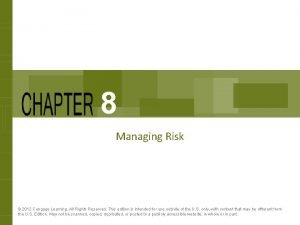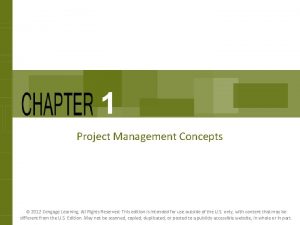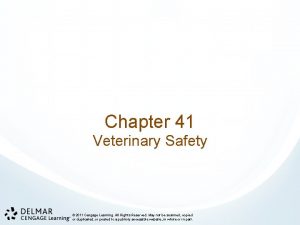Chapter 8 Safety Management 2012 Cengage Learning All















- Slides: 15

Chapter 8 Safety Management © 2012 Cengage Learning. All Rights Reserved.

Unintentional Injury Facts • Unintentional injuries are the primary cause of death among children under 14 years of age. (Table 8 -1). • Each year, more than 200, 000 children under 14 yrs. are treated in U. S. emergency departments for playgroundrelated injuries. © 2012 Cengage Learning. All Rights Reserved.

Unintentional Injury Facts • Approximately 68% of deaths due to injury -related causes occur among children and adolescents aged 5 -19 years © 2012 Cengage Learning. All Rights Reserved.

Unintentional Injury • Young children are at especially high risk for unintentional injury due to their: – Limited understanding of cause and effect – Immature motor skills – Inexperience – Exuberance © 2012 Cengage Learning. All Rights Reserved.

Risk Management • Requires continuous awareness and implementation of safety practices. • Requires that adults be aware of their own well-being and circumstances that might make them less effective in monitoring children’s safety. • Requires adults to be positive role models. © 2012 Cengage Learning. All Rights Reserved.

Risk Management (continued) Effective risk management is based on four principles: #1). Advanced planning and thoughtful selection of toys, play equipment, and activities - Is based on knowledge of children’s age, interests, and developmental abilities. © 2012 Cengage Learning. All Rights Reserved.

Developmental Risks • In what way do children’s developmental characteristics influence the type of injuries they are likely to sustain? • What are some of the potential sources of risk for: – – Infants Mobile toddlers Preschoolers School-age children © 2012 Cengage Learning. All Rights Reserved.

Risk Management (continued) • #1 Advanced planning and thoughtful selection of toys, play equipment, and activities (continued) – Learning experiences and activities: • Must be planned from beginning to end and supervised closely • Should take into account children’s interests and developmental skills • Should be designed to promote learning (and reduce misuse) © 2012 Cengage Learning. All Rights Reserved.

Risk Management (continued) • #2). Establishing and consistently enforcing rules - Rules are based on knowledge of children’s age, interests, and developmental abilities - Adults’ supervisory skills and the number of children in a group must also be taken into consideration - Rules must be appropriate for a given activity © 2012 Cengage Learning. All Rights Reserved.

Risk Management (continued) • #3 Providing quality supervision - In group settings, the majority of unintentional injuries occur during outdoor play - The amount of supervision required depends on the type of activity and children’s developmental abilities and limitations - Teachers should know first aid and be familiar with a program’s emergency policies and procedures. © 2012 Cengage Learning. All Rights Reserved.

Risk Management (continued) • #4 Safety education - Should be ongoing. - Should take advantage of formal and spontaneous learning opportunities. - Should gradually help children develop self-protection skills. © 2012 Cengage Learning. All Rights Reserved.

Safety and Toys • How to select toys and play equipment – Not all manufacturer’s age recommendations are appropriate. Know your children’s abilities and limitations. – Consider construction (non-toxic) and safety features (Table 8 -6) – Avoid toys with small parts (choking hazard), sharp edges, projectiles, loud noises, and long strings or cords (strangulation hazard). © 2012 Cengage Learning. All Rights Reserved.

Safety and Toys (continued) – Avoid toys and activities that may be too challenging or too far below children’s skill level. – Avoid Be alert to product recalls and recommendations (www. cpsc. org) © 2012 Cengage Learning. All Rights Reserved.

Additional Safety Considerations • Only provide art materials that pose no safety risks • Take special precautions to ensure that field trips are safe for children. – Thoughtful planning, emergency preparations, and notification procedures must be addressed. © 2012 Cengage Learning. All Rights Reserved.

Additional Safety Considerations • Establish feeding and care guidelines for classroom pets – Make sure children have no allergies to animals – Children and adults should always wash their hands after handling any animal. © 2012 Cengage Learning. All Rights Reserved.
 2012 cengage learning
2012 cengage learning Chapter 13 medical math assignment sheet cengage learning
Chapter 13 medical math assignment sheet cengage learning Chapter 7:10 respiratory system
Chapter 7:10 respiratory system Delmar cengage learning medical terminology
Delmar cengage learning medical terminology Chapter 5 the cardiovascular system labeling exercises
Chapter 5 the cardiovascular system labeling exercises Cengage learning heart diagram
Cengage learning heart diagram South-western cengage learning
South-western cengage learning 2009 delmar cengage learning
2009 delmar cengage learning Cengage learning heart diagram
Cengage learning heart diagram Chapter 1 matching medical terminology
Chapter 1 matching medical terminology Cengage learning australia
Cengage learning australia Measuring and recording apical pulse
Measuring and recording apical pulse Cengage learning
Cengage learning Cengage learning
Cengage learning Wadsworth cengage learning
Wadsworth cengage learning Cengage learning
Cengage learning





























